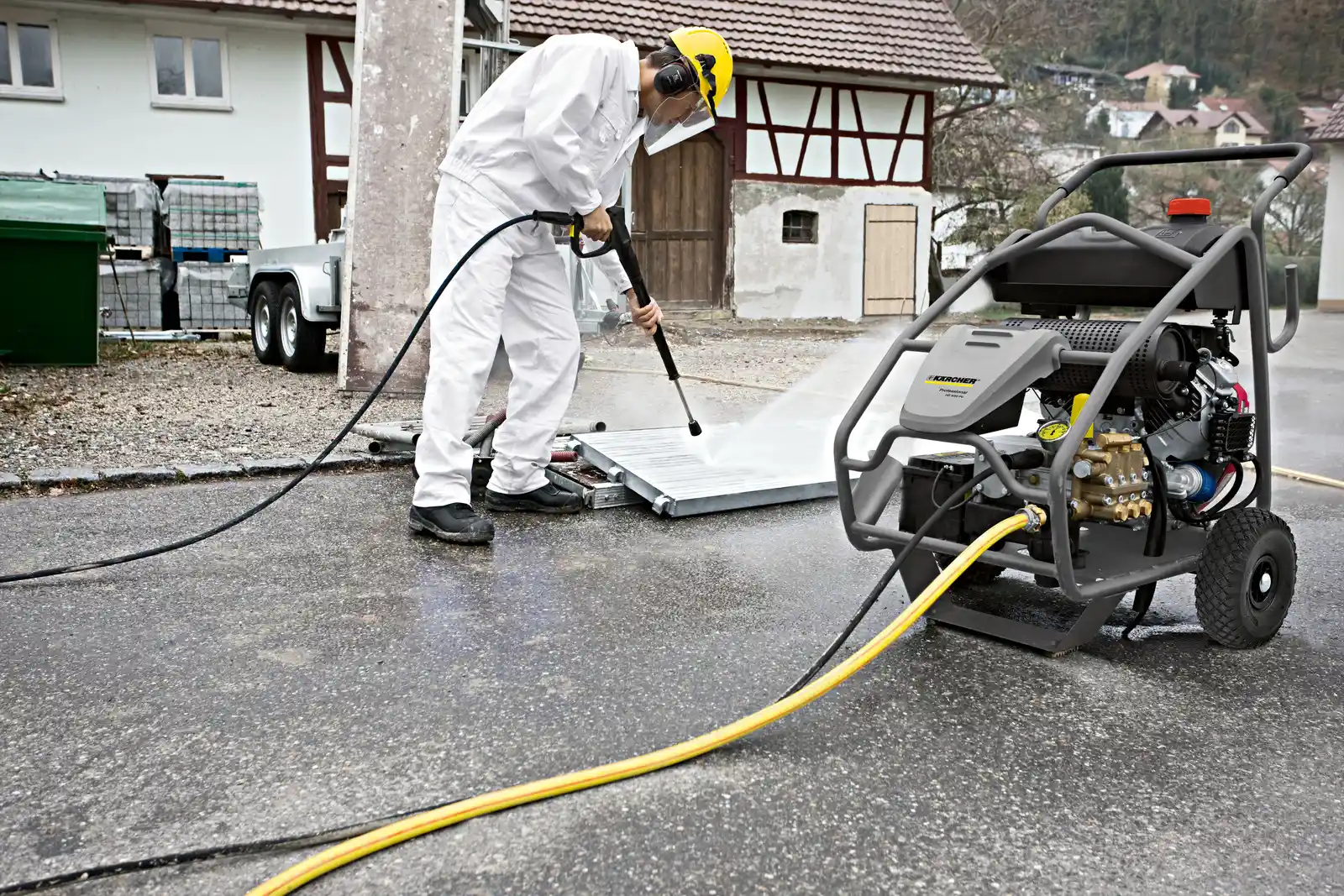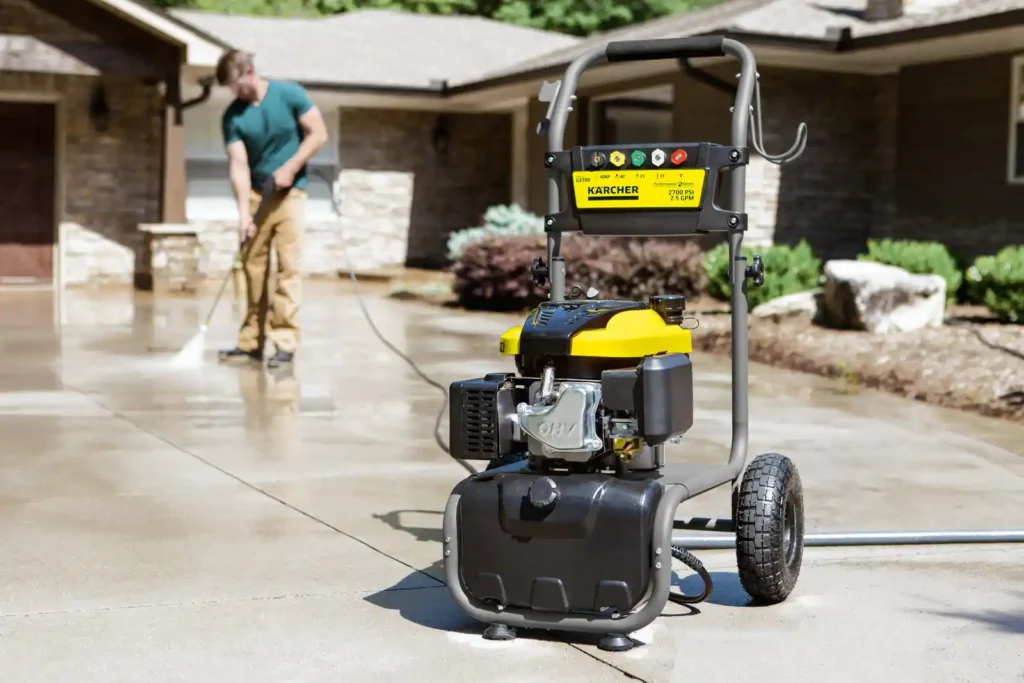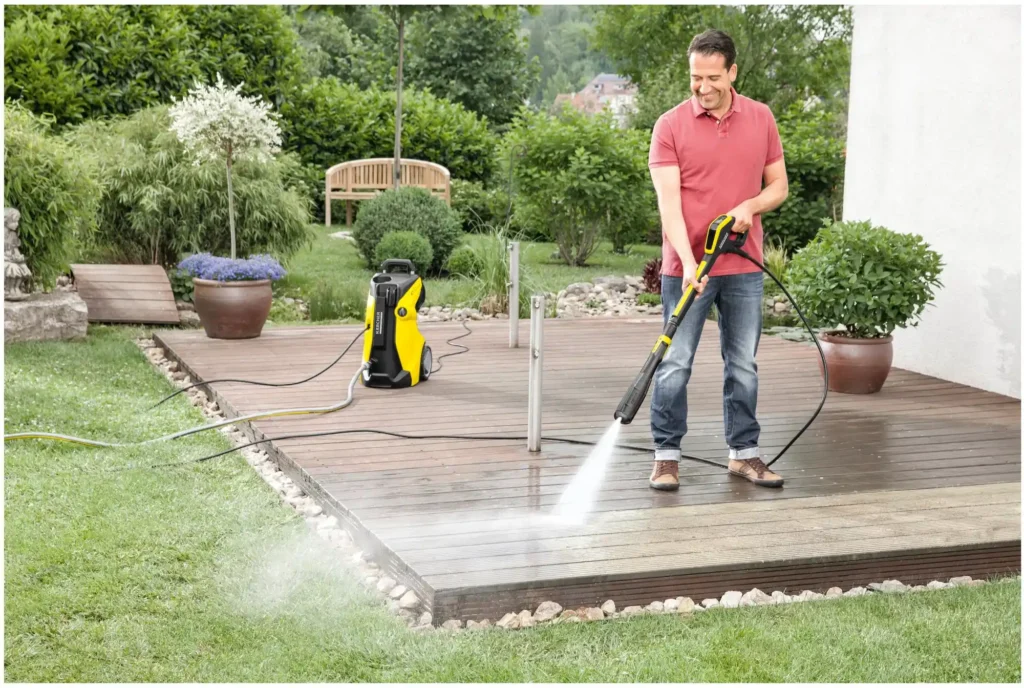Belt Drive vs Direct Drive Pressure Washers: What You Need to Know

Michael Adeniran is the CEO of Pressure King Inc. He has been dealing in commercial cleaning equipment for many years. He is one of the leading specialists and experts in commercial cleaning products.

A pressure washer is a powerful tool that quickly removes dirt, stains, and grime from many surfaces. It provides much deeper and faster cleaning than a regular garden hose. People use pressure washers to clean cars, driveways, sidewalks, decks, and even buildings.
A key thing to think about when picking a pressure washer is how the motor connects to the pump, also known as the drive system. The drive system of a pressure washer can be either a belt-driven or a direct-driven system.
This blog will cover the direct drive vs belt drive pressure washers’ pros and cons. You will find out how each one operates, how they differ, and which option might work best for you.
What is a belt drive pressure washer?
In a belt drive pressure washer, the engine powers the pump through a set of pulleys and a belt system. The engine spins the belt, which then powers the pump. Because of this arrangement, the pump runs at a slower speed, which means a longer life.
A belt-driven pressure washer works using three main parts: the motor, a belt system, and a belt drive pressure washer pump that controls the water pressure. Together, they create a strong and consistent cleaning power.
Belt drive power washers are typically used for larger jobs like cleaning buildings, sidewalks, or factory equipment. These washers are made for long continuous hours of work, which is why they are widely used throughout commercial and industrial work.
One major benefit of a belt driven power washer is that it runs with less noise and vibration, making it more comfortable to use for long jobs. Since the pump is not directly attached to the engine, engine vibration is not felt as much. Reduced vibration helps the machine last longer and protects its parts from damage over time.
What is a Direct Drive Pressure Washer?
A direct drive pressure washer is a type of machine where the pump is connected directly to the engine, allowing for a compact and simple design
A pressure washer with a direct setup is called a direct drive because the engine connects straight to the pump without using belts. There are fewer parts to take care of, and this setup is less expensive to repair than a belt drive setup. This is one of the reasons many homeowners and small business owners prefer a pressure washer direct drive.
Another advantage of a direct drive pressure washer is that it has a compact design, so it takes up less space and is easier to move. Direct drive pressure washers are an excellent option if you require a tool that is going to be simple to set up and easy to store.
The only disadvantage of any direct-powered pressure washer is that the pump in the pressure washer’s direct drive system spins faster than a belt drive; therefore, it could wear out sooner if you are using the pressure washer for long hours every day. However, if you are only doing short jobs or light-duty use, a direct drive pressure washer will perform just as well!

Major Differences Between Belt Drive and Direct Drive Washers
When comparing a direct drive washer versus a belt drive, it can be helpful to know how they vary in different ways of thinking. Here is a quick comparison:
1. Price
- Direct drive washers will generally have a lower price.
- Belt-driven power washers are more expensive because of the parts needed, like pulleys and belts.
2. Maintenance
- A direct drive pressure washer will require less maintenance as it has fewer moving parts.
- A pressure washer belt driven system will require you to always check the belt and pulleys, and the belt will have to be changed at some point.
3. Efficiency
- For quick jobs, direct drive washers, based on maximum efficiency, are far more energy efficient.
- A belt driven power washer will carry the job out better for longer tasks because the pump will not heat, in most cases, as quickly.
4. Longevity
- Belt driven pressure washers will last longer than direct drive versions because the pump runs at a slower speed.
- Direct drive washers can wear out very quickly, especially if used for longer hours on many occasions.
5. Best Practices
- Direct drive pressure washers are best for home cleaning, light-duty jobs, or occasional.
- A belt-driven power washer is best for commercial use, longer cleaning tasks, or daily work.
Direct Drive vs Belt Drive Pressure Washers: Pros and Cons
Each type of pressure washer has unique benefits and drawbacks, depending on how and where you plan to use it. This short list should help you in deciding which type of washer to purchase for your home or business. Understand the key differences between belt drive and direct drive pressure washers to find the right match for your cleaning needs.
Direct Drive Pressure Washer – Pros
- Costs less than a belt drive pressure washer
- Small, light, and extremely portable
- Little maintenance
- Great for jobs that are quick and light
- Good for homeowner’s work and weekend gigs
Direct Drive Pressure Washer – Cons
- The pump wears out quickly with extended use
- Not designed for daily heavy use
- It can quickly heat up with the pump running at full engine speed
Belt Driven Pressure Washer – Pros
- The pump lasts longer because it runs slower
- Runs smoother with less vibration
- Stays cooler with extended use
- Heavy duty and designed for professional use and larger cleaning tasks
- Able to work long periods with less wear on equipment
Belt Driven Pressure Washer – Cons
- It costs more than a direct drive washer
- It needs service at many regular intervals, including belt replacements
- It has a bulkier build, which makes it less convenient to transport from place to place.

Can a Direct Drive Pressure Washer Use Water from a Tank?
Sometimes, a direct drive pressure washer can use water from a tank, but a direct drive pressure washer is not the best option for that. These machines usually work best when connected to a steady and pressurized water supply, like a hoses or tap. If the water pressure is low, the pump won’t work properly and may be damaged.
Direct drive pressure washer setups have more trouble pulling water from a tank than a belt drive. A belt drive pressure washer pump is better suited for lower water pressure and pulling water from a tank. That’s why many professionals prefer a pressure washer belt drive for working in remote places.
If you’re operating in an area without running water, a portable pressure washer with a water tank might be a better option. A portable pressure washer with a water tank gives you more flexibility and is designed for jobs that require you to transport water to the site. Be sure to check whether the model is belt-driven or direct drive based on your needs!
Which One Should You Choose?
When it comes to choosing a direct drive washer vs a belt, it depends on how you intend to use it moving forward. If it is just for small or occasional cleaning jobs at home or around the property, a direct drive pressure washer is an economical buy. If you will be doing long or daily cleaning jobs, a belt drive pressure washer will last longer and perform better. Think about how much you want to spend, how often you’ll use it, and the type of cleaning tasks you need it for.
Conclusion
Direct drive and belt drive pressure washers work well, but each type is built to handle different cleaning tasks and usage levels. A direct drive pressure washer is great for quick cleanups, light-duty tasks, and for anyone looking for a low-maintenance option. In contrast, the belt drive pressure washer is designed for long jobs, heavy dirt, and more frequent use.
So now that you know the direct drive vs. belt drive pressure washers: pros and cons, you can decide which is going to fit your job the best. Whether it is for home use or heavy-duty work, choosing the right pressure washer with any extra features will lead to a smarter and faster method of cleaning.
Frequently Asked Questions (Faqs)
What is a belt drive pressure washer compared to a direct drive pressure washer?
A more heat and wear-reducing pump-to-motor connection uses a belt and pulleys in a belt drive pressure washer. A direct drive is one that links the pump and the engine together, providing ease of speed, small size, and low cost.
Which is more long-lived belt drive or direct drive pressure washers?
Pressure washers driven by belts tend to have a longer life span since the belt takes up vibration, minimizes heat buildup, and makes less rpm. Direct drive units are hotter/ faster and lighter loads may put a shorter life on the pump, but continue to be effective at lighter tasks.
Are the pressure washers using belt drive more costly relative to direct drive?
Belt drive pressure washers tend to be expensive in the short term, yes, since they are more resistant and have a longer overall performance. Direct drive motors tend to be cheaper and thus are appealing quality low end to low-end domestic consumers or to small industries, which can justify the potential higher cost of replacement but could be disposable earlier than belt drive.
Are belt drive pressure washers more maintenance intense?
The belt drive models need frequent belt checks and replacements; nevertheless, the general maintenance is easy. They have fewer RPMs of operation, which limits wear to the pumps. Direct drive models require less adjustment, but can require earlier pump service because of hotter, faster running conditions.
Which is more portable pressure washer?
Direct drive pressure washers are smaller and lighter in weight, which makes them easier to transport. Bulkier structures are because of the pulley system built in belt drive units, as they are heavier and hence built to be put in use at a stationary or mounted position. They are suited to be used in the hands of professionals, where durability is what is more important than being easily transportable.





